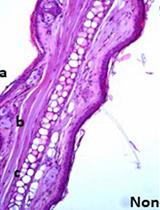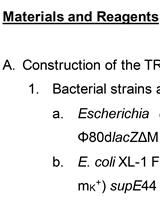- EN - English
- CN - 中文
Use of Gas Chromatography to Quantify Short Chain Fatty Acids in the Serum, Colonic Luminal Content and Feces of Mice
利用气相色谱法定量分析小鼠血清、结肠管腔内容物和粪便中短链脂肪酸
发布: 2018年11月20日第8卷第22期 DOI: 10.21769/BioProtoc.3089 浏览次数: 14375
评审: David CisnerosManish Kumar PatelSesha Lakshmi Arathi Paluri
Abstract
Short-Chain Fatty Acids (SCFAs) are a product of the fermentation of resistant starches and dietary fibers by the gut microbiota. The most important SCFA are acetate (C2), propionate (C3) and butyrate (C4). These metabolites are formed and absorbed in the colon and then transported through the hepatic vein to the liver. SCFAs are more concentrated in the intestinal lumen than in the serum. Butyrate is largely consumed in the gut epithelium, propionate in the liver and acetate in the periphery. SCFAs act on many cells including components of the immune system and epithelial cells by two main mechanisms: activation of G-protein coupled receptors (GPCRs) and inhibition of histone deacetylase. Considering the association between changes in SCFA concentrations and the development of diseases, methods to quantify these acids in different biological samples are important. In this study, we describe a protocol using gas chromatography to quantify SCFAs in the serum, feces and colonic luminal content. Separation of compounds was performed using a DB-23 column (60 m x 0.25 mm internal diameter [i.d.]) coated with a 0.15 µm thick layer of 80.2% 1-methylnaphatalene. This method has a good linear range (15-10,000 µg/ml). The precision (relative standard deviation [RSD]) is less than 15.0% and the accuracy (error relative [ER]) is within ± 15.0%. The extraction efficiency was higher than 97.0%. Therefore, this is cost effective and reproducible method for SCFA measurement in feces and serum.
Keywords: Short chain fatty acid (短链脂肪酸)Background
The microbiota is a complex, heterogeneous and dynamic group of microorganisms (bacteria, viruses and fungi) that colonizes the tissues in direct contact with the external environment including the skin and the genitourinary, intestinal and respiratory tracts. Several studies have demonstrated recently that these microorganisms are important for maintaining host homeostasis. Indeed, changes in their composition can lead to dysbiosis, as observed in specific pathological conditions, and have been associated with their development, as shown for inflammatory bowel disease, asthma, obesity and other chronic inflammatory conditions (Ferreira et al., 2014; Nishida et al., 2018; Sokolowska et al., 2018).
Short chain fatty acids are bacterial metabolites produced by components of the microbiota. The most abundant and studied molecules of this class are acetic, propionic and butyric acids, which are normally found in their deprotonated forms (e.g., acetate, propionate and butyrate). SCFAs modify important processes including metabolism, immune system development and activation, and intestinal barrier function strategies (den Besten et al., 2013; Correa-Fiz et al., 2016; Koh et al., 2016) have been used for changing SCFAs bioavailability in the gut including administration of probiotics (Andrade-Oliveira et al., 2015; Mendes et al., 2017), antibiotics (Fellows et al., 2018), diets with different fiber contents (Vieira et al., 2017), SCFAs in the drinking water or the butyric acid pro-drug (tributyrin) (Vinolo et al., 2012; Vieira et al., 2017). Taken together, these strategies allow us to investigate the role of these metabolites in vivo in different disease models. In this context, it is essential to have a robust method for measuring the levels of these molecules in biological samples such as feces, luminal content or serum.
Gas chromatography (GC) is most commonly used for SCFA analysis due to compatibility with the chemical properties of SCFAs, such as volatility, and the suitability of the detectors that can be coupled to this equipment, such as flame ionization detector (FID). FID is the most widely used for analysis of SCFAs. Due to the large amount of compounds present in the matrix, the sample should be pretreated using extraction and derivatization procedures. Recently, several techniques of derivatization have been described to obtain more stable compounds and provide greater compatibility between the stationary phase and the analytes (Karlsson et al., 2010; Walton et al., 2012; Zhang et al., 2013). On the other hand, the use of derivation techniques has critical disadvantages, including the points that it is time-consuming, there can be losses of SCFAs, it is costly due to the use of large quantities of reagents, and the risk of occupational exposure to allergenic and toxic reagents. Some authors have described filtration and ultracentrifugation techniques to avoid the disadvantages of derivatization and obtain a fast sample preparation (Cuervo et al., 2013; Salazar et al., 2015). In spite of this, the run time is usually increased due to low purification of the samples, which increases the quantities and variety of compounds needed for separation in the column. We have chosen the ultracentrifugation technique in this protocol. Here, we describe a method that we have used to measure SCFAs in biological samples using gas chromatography equipped with FID and a liquid-liquid extraction technique. The column used in this method is composed of a high polarity stationary phase, which makes analysis of the SCFAs possible. The liquid-liquid extraction offers some advantages such as greater sample recuperation, higher sample purification, time optimization and greater separation and peak resolution in chromatograms.
Materials and Reagents
- 100-1,000 µl pipette tips (KASVI, catalog number: K8-1000B)
- Eppendorf Safe-Lock Tubes, 1.5 ml (Eppendorf, catalog number: 0030120086)
- Amber, write-on spot, certified, 2 ml, screw top vial packs (Agilent Technologies, catalog number: 5182-0554)
- Serum, colonic luminal content and feces of C57BL/6 mice
- Hydrochloric acid, 37% (v/v) (Sigma-Aldrich, catalog number: 320331)
- Anhydrous citric acid (Cinética Produtos Químicos, catalog number: 278)
- Sodium chloride (Cinética Produtos Químicos, catalog number: 415)
- Tetrahydrofuran (Merck, catalog number: 1081012500)
- Acetonitrile (Sigma-Aldrich, catalog number: 60004)
- N-butanol (Sigma-Aldrich, catalog number: 34867)
- Acetic acid, analytical standard, GC assay ≥ 9.8% (Sigma-Aldrich, catalog number: 71251)
- Propionic acid, analytical standard, GC assay ≥ 9.8% (Sigma-Aldrich, catalog number: 94425)
- Butyric acid, analytical standard, GC assay ≥ 9.8% (Sigma-Aldrich, catalog number: 19215)
- HCl
- Distilled water
- 1-methylnaphthalene
- N2
- H2
- 0.1 M HCl solution (see Recipes)
- 3,000 µg/ml acetic acid in serum stock solution (see Recipes)
- 3,000 µg/ml propionic acid stock solution (see Recipes)
- 3,000 µg/ml butyric acid stock solution (see Recipes)
- 1,000 µg/ml SCFAs standard mixture (see Recipes)
Equipment
- J&W DB-23 GC column, 60 m, 0.32 mm, 0.25 µm, 7 inch cage (Agilent Technologies, catalog number: 123-2362)
- Forceps
- Freezer FE26/127V (Electrolux Appliances, model: FE26, catalog number: 04251FBA106/ 04251FBB206)
- Stainless steel double spatula, 180 mm length x 3 mm diameter (Metalic Acessórios para Laboratório, catalog number: 063-A3)
- PIPETMAN Classic P1000 pipette (Gilson, catalog number: 20170-170)
- Gas Chromatograph Agilent 6850 series (Agilent Technologies, discontinued by the manufacturer)
- DB 23 Agilent capillary column, 60 m x 0.25 mm internal diameter (i.d.)
- Oven
- Automatic liquid sampler 7683B (Agilent Technologies, catalog number: G2880A)
- Analytical balance (SHIMADZU, model: ATX224 series, catalog number not found)
- Vortex mixer (Phenix Luferco, model: AP56)
- Centrifuge 5810 R (Eppendorf, model: 5810 R, catalog number: 5810000424)
- Gas Chromatograph Shimadzu 2010 model, equipped with FID (SHIMADZU, catalog number: C184-E019)
- AOC-20i automatic liquid sampler (SHIMADZU, model: AOC-20i)
Software
- EZChrom software, 3.3.1 version (Agilent Technologies)
- GC solution software, 3.2 version (SHIMADZU)
Procedure
文章信息
版权信息
© 2018 The Authors; exclusive licensee Bio-protocol LLC.
如何引用
Ribeiro, W. R., Vinolo, M. A. R., Calixto, L. A. and Ferreira, C. M. (2018). Use of Gas Chromatography to Quantify Short Chain Fatty Acids in the Serum, Colonic Luminal Content and Feces of Mice. Bio-protocol 8(22): e3089. DOI: 10.21769/BioProtoc.3089.
分类
微生物学 > 微生物-宿主相互作用 > 体内实验模型 > 哺乳动物
免疫学 > 动物模型 > 小鼠
系统生物学 > 代谢组学 > 全生物体
您对这篇实验方法有问题吗?
在此处发布您的问题,我们将邀请本文作者来回答。同时,我们会将您的问题发布到Bio-protocol Exchange,以便寻求社区成员的帮助。
提问指南
+ 问题描述
写下详细的问题描述,包括所有有助于他人回答您问题的信息(例如实验过程、条件和相关图像等)。
Share
Bluesky
X
Copy link














